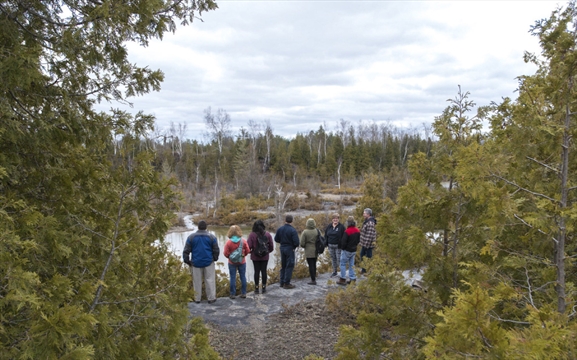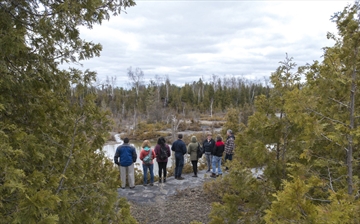The Greenbelt Brings Ontarians Together
From economic, recreational, complete communities and diverse rural areas, the Greenbelt can extend in governance how we develop and engage our local communities.
By Beatrice Ekwa Ekoko
Published April 15, 2015
Published April 15, 2015
The Greenbelt is this thing we have in Ontario. The west can have its Prairies, its Rockies. Quebec can take its Shield, its Appalachian mountains. We have the Greenbelt: covering the Niagara Escarpment from Niagara falls to Tobermory, the Oak Ridges Moraine, and the hundred of thousands of acres of protected countryside that wraps around the Greater Golden Horseshoe.
'Entering the Greenbelt' sign (Image Credit: Friends of the Greenbelt)
It might be the youngest, but it's the biggest, the strongest, the most protected greenbelt in the entire world-- all 1.8 million bountiful acres of it. Ontarians know this as a thing of beauty and of value.
The Greenbelt envelops us.
And yet, apart from the signs that say, "Entering the Greenbelt" on the occasional jaunt to the rural areas, we don't give it much thought.
But the 2015 review of the Greenbelt Plan (along with the three other land use plans) is bringing this expansive swath of land to everyone's attention.
And now I am envisioning it, stretching across the province, its sheltering forests filtering our air; wetlands cleaning our water, and open meadows feeding beneficial critters for the wonders they provide; soil, good rich soil for farmers; and fingers of green reaching into our urban centres - gentle reminders that the Greenbelt is here, connecting the rural to the urban.
I tell you, I'm in love with the Greenbelt. Like Gandalf in Lord of the Rings, I want to bellow, "You shall not pass!" at anyone who dares to think about diminishing it.
We eat of its fruit: fresh produce, homegrown. We drink deeply of its wines (I prefer red). We hike along its thousands of meandering trails, dip fishing poles into its creeks, take photos with our friends and families, cross country ski its rolling hills. Valley land, wetland, marsh, woodland, sand barren and savannah, tall grass prairie and fen.
Looking up through the branches of hemlock, spruce, sassafras and pine, I admire this wild beauty and marvel at the heritage systems that most of us take for granted; always forgetting that the services of its green infrastructure are worth billions of dollars - for those inclined to measure the immeasurable in money.
Many of our livelihoods depend on it. Without question, all our children's future does.
There is this ancient idea called "the common good," which refers to the benefit of all people. It's an idea that needs resuscitating.
I'm thinking the Greenbelt can do this. The Greenbelt is this common good because it's in the interest and general wellbeing of all of us, today and tomorrow as the reality of an uncertain climate future looms.
The Greenbelt brings Ontarians together. With clearly set boundaries to halt unnecessary expansion onto prime farm and ecologically sensitive lands across Ontario, we can work within these boundaries, to grow, and thrive.
It's like rural planning consultant Margaret Walton said, back in 2006 when she coordinated the development of a rural agriculture action plan for Hamilton: "I think we need to look at agricultural land as a non-renewable resource, and not as something that is urban land in waiting."
Because, you know, there is this little something we humans like to do, called eating. Can we really afford to lose any more agriculture land?
I propose that we grow the belt to areas still outside of it. I propose that the Greenbelt plan be strengthened further to impact all the decisions we make concerning our communal lives.
From economic, recreational, complete communities and diverse rural areas, the Greenbelt can extend in governance how we develop and engage our local communities. Let it be the context from which our decisions are made towards a resilient, thriving province.



